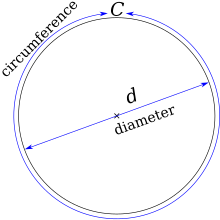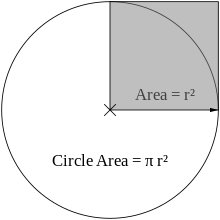this is a way to know about Pi
π (sometimes written pi) is a mathematical constant whose value is the ratio of any circle's circumference to its diameter in Euclidean space; this is the same value as the ratio of a circle's area to the square of its radius. It is approximately equal to 3.141593 in the usual decimal notation (see the table for its representation in some other bases). The constant is also known as Archimedes Constant, although this name is rather uncommon in modern, western, English-speaking contexts. Many formulae from mathematics, science, and engineering involve π, which is one of the most important mathematical and physical constants.[5]
π is an irrational number, which means that its value cannot be expressed exactly as a fraction m/n, where m and n are integers. Consequently, its decimal representation never ends or repeats. It is also a transcendental number, which implies, among other things, that no finite sequence of algebraic operations on integers (powers, roots, sums, etc.) can be equal to its value; proving this was a late achievement in mathematical history and a significant result of 19th century German mathematics. Throughout the history of mathematics, there has been much effort to determine π more accurately and to understand its nature; fascination with the number has even carried over into non-mathematical culture.
The Greek letter π, often spelled out pi in text, was adopted for the number from the Greek word for perimeter "περίμετρος", first by William Jones in 1707, and popularized by Leonhard Euler in 1737.[
The letter π
The constant is named "π" because "π" is the first letter of the Greek words περιφέρεια (periphery) and περίμετρος (perimeter), probably referring to its use in the formula to find the circumference, or perimeter, of a circle.[7] π is Unicode character U+03C0 ("Greek small letter pi").[8]
Geometric definition
In Euclidean plane geometry, π is defined as the ratio of a circle's circumference to its diameter:[7]Alternatively π can be also defined as the ratio of a circle's area (A) to the area of a square whose side is equal to the radius:[7][9]
Irrationality and transcendence

π is also a transcendental number, meaning that there is no polynomial with rational coefficients for which π is a root.[17] This was proved by Ferdinand von Lindemann in 1882. An important consequence of the transcendence of π is the fact that it is not constructible. Because the coordinates of all points that can be constructed with compass and straightedge are constructible numbers, it is impossible to square the circle: that is, it is impossible to construct, using compass and straightedge alone, a square whose area is equal to the area of a given circle.[18] This is historically significant, for squaring a circle is one of the easily understood elementary geometry problems left to us from antiquity; many amateurs in modern times have attempted to solve each of these problems, and their efforts are sometimes ingenious, but in this case, doomed to failure: a fact not always understood by the amateur involved.
Decimal representation
- 3.14159 26535 89793 23846 26433 83279 50288 41971 69399 37510
- See the links below and those at sequence A000796 in OEIS for more digits.
Because π is an irrational number, its decimal representation does not repeat, and therefore does not terminate. This sequence of non-repeating digits has fascinated mathematicians and laymen alike, and much effort over the last few centuries has been put into computing ever more of these digits and investigating π's properties.[23] Despite much analytical work, and supercomputer calculations that have determined over 1 trillion digits of the decimal representation of π, no simple base-10 pattern in the digits has ever been found.[24] Digits of the decimal representation of π are available on many web pages, and there is software for calculating the decimal representation of π to billions of digits on any personal computer.
Estimating π
π can also be calculated using purely mathematical methods. Most formulae used for calculating the value of π have desirable mathematical properties, but are difficult to understand without a background in trigonometry and calculus. However, some are quite simple, such as this form of the Gregory-Leibniz series:[27]
 , correct to 9 decimal places. This computation is an example of the van Wijngaarden transformation.[29]
, correct to 9 decimal places. This computation is an example of the van Wijngaarden transformation.[29]History

The early history of π from textual sources roughly parallels the development of mathematics as a whole.[34] Some authors divide progress into three periods: the ancient period during which π was studied geometrically, the classical era following the development of calculus in Europe around the 17th century, and the age of digital computers.[35]
Antiquity
That the ratio of the circumference to the diameter of a circle is the same for all circles, and that it is slightly more than 3, was known to Ancient Egyptian, Babylonian, Indian and Greek geometers. The earliest known textually evidenced approximations date from around 1900 BC; they are 25/8 (Babylonia) and 256/81 (Egypt), both within 1% of the true value.[7] The Indian text Shatapatha Brahmana gives π as 339/108 ≈ 3.139.Archimedes (287–212 BC) was the first to estimate π rigorously. He realized that its magnitude can be bounded from below and above by inscribing circles in regular polygons and calculating the outer and inner polygons' respective perimeters:[36]
By using the equivalent of 96-sided polygons, he proved that 310/71 < π < 31/7.[36] The average of these values is about 3.14185.
Ptolemy, in his Almagest, gives a value of 3.1416, which he may have obtained from Apollonius of Perga.[37]
Around AD 265, the Wei Kingdom mathematician Liu Hui provided a simple and rigorous iterative algorithm to calculate π to any degree of accuracy. He himself carried through the calculation to a 3072-gon and obtained an approximate value for π of 3.1416.[38] Later, Liu Hui invented a quick method of calculating π and obtained an approximate value of 3.14 with only a 96-gon,[38] by taking advantage of the fact that the difference in area of successive polygons forms a geometric series with a factor of 4.
Around 480, the Chinese mathematician Zu Chongzhi demonstrated that π ≈ 355/113, and showed that 3.1415926 < π < 3.1415927[38] using Liu Hui's algorithm applied to a 12288-gon. This value would remain the most accurate approximation of π available for the next 900 years.
Second Millennium AD
Until the second millennium AD, estimations of π were accurate to fewer than 10 decimal digits. The next major advances in the study of π came with the development of infinite series and subsequently with the discovery of calculus, which permit the estimation of π to any desired accuracy by considering sufficiently many terms of a relevant series. Around 1400, Madhava of Sangamagrama found the first known such series:The first major European contribution since Archimedes was made by the German mathematician Ludolph van Ceulen (1540–1610), who used a geometric method to give an estimate of π that is correct to 35 decimal digits. He was so proud of the calculation, which required the greater part of his life, that he had the digits engraved into his tombstone.[41]
Around the same time, the methods of calculus and determination of infinite series and products for geometrical quantities began to emerge in Europe. The first such representation was the Viète's formula,
In 1706 John Machin was the first to compute 100 decimals of π, using the formula
Theoretical advances in the 18th century led to insights about π's nature that could not be achieved through numerical calculation alone. Johann Heinrich Lambert proved the irrationality of π in 1761, and Adrien-Marie Legendre also proved in 1794 π2 to be irrational. When Leonhard Euler in 1735 solved the famous Basel problem – finding the exact value of
William Jones' book A New Introduction to Mathematics from 1706 is said to be the first use of the Greek letter π for this constant, but the notation became particularly popular after Leonhard Euler adopted it in 1737.[43] He wrote:
There are various other ways of finding the Lengths or Areas of particular Curve Lines, or Planes, which may very much facilitate the Practice; as for instance, in the Circle, the Diameter is to the Circumference as 1 to (16/5 − 4/239) − 1/3(16/53 − 4/2393) + ... = 3.14159... = π[7]
Computation in the computer age
Although practically a physicist needs only 39 digits of Pi to make a circle the size of the observable universe accurate to one atom of hydrogen, the number itself as a mathematical curiosity has created many challenges in different fields.The advent of digital computers in the 20th century led to an increased rate of new π calculation records. John von Neumann et al. used ENIAC to compute 2037 digits of π in 1949, a calculation that took 70 hours.[44][45] Additional thousands of decimal places were obtained in the following decades, with the million-digit milestone passed in 1973. Progress was not only due to faster hardware, but also new algorithms. One of the most significant developments was the discovery of the fast Fourier transform (FFT) in the 1960s, which allows computers to perform arithmetic on extremely large numbers quickly.
In the beginning of the 20th century, the Indian mathematician Srinivasa Ramanujan found many new formulas for π, some remarkable for their elegance, mathematical depth and rapid convergence.[46] One of his formulas is the series,
Whereas series typically increase the accuracy with a fixed amount for each added term, there exist iterative algorithms that multiply the number of correct digits at each step, with the downside that each step generally requires an expensive calculation. A breakthrough was made in 1975, when Richard Brent and Eugene Salamin independently discovered the Brent–Salamin algorithm, which uses only arithmetic to double the number of correct digits at each step.[47] The algorithm consists of setting
An important recent development was the Bailey–Borwein–Plouffe formula (BBP formula), discovered by Simon Plouffe and named after the authors of the paper in which the formula was first published, David H. Bailey, Peter Borwein, and Simon Plouffe.[51] The formula,
If a formula of the form
In 2006, Simon Plouffe, using the integer relation algorithm PSLQ, found a series of formulas.[53] Let q = eπ (Gelfond's constant), then
In the previous formula, if k is of the form 4m + 3, then the formula has the particularly simple form,
Pi and continued fraction
The sequence of partial denominators of the simple continued fraction of π does not show any obvious pattern:[4]Memorizing digits
On June, 17th, 2009 Andriy Slyusarchuk, a Ukrainian neurosurgeon, medical doctor and professor claimed to have memorized 30 million digits of pi, which were printed in 20 volumes of text.[58] Although he did not recite the entire 30 million digits that he claims to have memorized, some media claim that he was able to recite ten randomly selected sequences from the printed text of the 30 million digits.
There are many ways to memorize π, including the use of "piems", which are poems that represent π in a way such that the length of each word (in letters) represents a digit. Here is an example of a piem, originally devised by Sir James Jeans: How I need (or: want) a drink, alcoholic in nature (or: of course), after the heavy lectures (or: chapters) involving quantum mechanics.[59][60] Notice how the first word has 3 letters, the second word has 1, the third has 4, the fourth has 1, the fifth has 5, and so on. The Cadaeic Cadenza contains the first 3835 digits of π in this manner.[61] Piems are related to the entire field of humorous yet serious study that involves the use of mnemonic techniques to remember the digits of π, known as piphilology. In other languages there are similar methods of memorization. However, this method proves inefficient for large memorizations of π. Other methods include remembering patterns in the numbers and the method of loci.[62][63]
Advanced properties
Numerical approximations
Consequently, numerical calculations must use approximations of π. For many purposes, 3.14 or 22/7 is close enough, although engineers often use 3.1416 (5 significant figures) or 3.14159 (6 significant figures) for more precision. The approximations 22/7 and 355/113, with 3 and 7 significant figures respectively, are obtained from the simple continued fraction expansion of π. The approximation 355⁄113 (3.1415929...) is the best one that may be expressed with a three-digit or four-digit numerator and denominator; the next good approximation 103993/33102 (3.14159265301...) requires much bigger numbers, due to the large number 292 in the continued fraction expansion.[3]
The earliest numerical approximation of π is almost certainly the value 3.[36] In cases where little precision is required, it may be an acceptable substitute. That 3 is an underestimate follows from the fact that it is the ratio of the perimeter of an inscribed regular hexagon to the diameter of the circle.
Open questions
The most pressing open question about π is whether it is a normal number—whether any digit block occurs in the expansion of π just as often as one would statistically expect if the digits had been produced completely "randomly", and that this is true in every integer base, not just base 10.[65] Current knowledge on this point is very weak; e.g., it is not even known which of the digits 0,...,9 occur infinitely often in the decimal expansion of π,[66] although it is clear that at least two such digits must occur infinitely often, since otherwise π would be rational, which it is not.Bailey and Crandall showed in 2000 that the existence of the above mentioned Bailey-Borwein-Plouffe formula and similar formulas imply that the normality in base 2 of π and various other constants can be reduced to a plausible conjecture of chaos theory.[67]
It is also unknown whether π and e are algebraically independent, although Yuri Nesterenko proved the algebraic independence of {π, eπ, Γ(1/4)} in 1996.[68]
Use in mathematics and science
Geometry and trigonometry
 and
andFrom the unit-circle definition of the trigonometric functions also follows that the sine and cosine have period 2π. That is, for all x and integers n, sin(x) = sin(x + 2πn) and cos(x) = cos(x + 2πn). Because sin(0) = 0, sin(2πn) = 0 for all integers n. Also, the angle measure of 180° is equal to π radians. In other words, 1° = (π/180) radians.
In modern mathematics, π is often defined using trigonometric functions, for example as the smallest positive x for which sin x = 0, to avoid unnecessary dependence on the subtleties of Euclidean geometry and integration. Equivalently, π can be defined using the inverse trigonometric functions, for example as π = 2 arccos(0) or π = 4 arctan(1). Expanding inverse trigonometric functions as power series is the easiest way to derive infinite series for π.
Complex numbers and calculus


Physics
Although not a physical constant, π appears routinely in equations describing fundamental principles of the Universe, due in no small part to its relationship to the nature of the circle and, correspondingly, spherical coordinate systems. Using units such as Planck units can sometimes eliminate π from formulae.- Heisenberg's uncertainty principle, which shows that the uncertainty in the measurement of a particle's position (Δx) and momentum (Δp) can not both be arbitrarily small at the same time:[74]
- Coulomb's law for the electric force, describing the force between two electric charges (q1 and q2) separated by distance r:[76]
- Kepler's third law constant, relating the orbital period (P) and the semimajor axis (a) to the masses (M and m) of two co-orbiting bodies:
Probability and statistics
In probability and statistics, there are many distributions whose formulas contain π, including:- the probability density function for the normal distribution with mean μ and standard deviation σ, due to the Gaussian integral:[78]
- the probability density function for the (standard) Cauchy distribution:[79]
 for any probability density function f(x), the above formulas can be used to produce other integral formulas for π.[80]
for any probability density function f(x), the above formulas can be used to produce other integral formulas for π.[80]Buffon's needle problem is sometimes quoted as an empirical approximation of π in "popular mathematics" works. Consider dropping a needle of length L repeatedly on a surface containing parallel lines drawn S units apart (with S > L). If the needle is dropped n times and x of those times it comes to rest crossing a line (x > 0), then one may approximate π using the Monte Carlo method:[81][82][83][84]
 Though this result is mathematically impeccable, it cannot be used to determine more than very few digits of π by experiment. Reliably getting just three digits (including the initial "3") right requires millions of throws,[81] and the number of throws grows exponentially with the number of digits desired. Furthermore, any error in the measurement of the lengths L and S will transfer directly to an error in the approximated π. For example, a difference of a single atom in the length of a 10-centimeter needle would show up around the 9th digit of the result. In practice, uncertainties in determining whether the needle actually crosses a line when it appears to exactly touch it will limit the attainable accuracy to much less than 9 digits.
Though this result is mathematically impeccable, it cannot be used to determine more than very few digits of π by experiment. Reliably getting just three digits (including the initial "3") right requires millions of throws,[81] and the number of throws grows exponentially with the number of digits desired. Furthermore, any error in the measurement of the lengths L and S will transfer directly to an error in the approximated π. For example, a difference of a single atom in the length of a 10-centimeter needle would show up around the 9th digit of the result. In practice, uncertainties in determining whether the needle actually crosses a line when it appears to exactly touch it will limit the attainable accuracy to much less than 9 digits.Geomorphology and chaos theory
Under ideal conditions (uniform gentle slope on an homogeneously erodible substrate), the ratio between the actual length of a river and its straight-line from source to mouth length tends to approach π.[85] Albert Einstein was the first to suggest that rivers have a tendency towards an ever more loopy path because the slightest curve will lead to faster currents on the outer side, which in turn will result in more erosion and a sharper bend. The sharper the bend, the faster the currents on the outer edge, the more the erosion, the more the river will twist and so on. However, increasing loopiness will result in rivers doubling back on themselves and effectively short-circuiting, creating an ox-bow lake. The balance between these two opposing factors leads to an average ratio of π between the actual length and the direct distance between source and mouth.[86]In popular culture
Probably because of the simplicity of its definition, the concept of pi and, especially its decimal expression, have become entrenched in popular culture to a degree far greater than almost any other mathematical construct.[87] It is, perhaps, the most common ground between mathematicians and non-mathematicians.[88] Reports on the latest, most-precise calculation of π (and related stunts) are common news items.[89][90][91]Pi Day (March 14, from 3.14) is observed in many schools.[92] At least one cheer at the Massachusetts Institute of Technology includes "3.14159!"[93]
On November 7, 2005, alternative musician Kate Bush released the album, Aerial. The album contains the song "π" whose lyrics consist principally of Bush singing the digits of π to music, beginning with "3.14"[94]
In Carl Sagan's novel Contact, pi played a key role in the story and suggested that there was a message buried deep within the digits of pi placed there by whoever created the universe. This part of the story was left out of the film adaptation of the novel. Selengkapnya...
































![\pi=[3;7,15,1,292,1,1,1,2,1,3,1,14,2,1,1,2,2,2,2,1,84,\cdots]](http://upload.wikimedia.org/math/1/0/8/108f4286d5ad19cd2d6aa6910dbe7431.png)


















